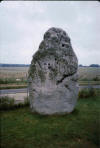| Overview of
Stonehenge,
England
"Sometimes these huge
stones were arranged in a circle known as a cromlech
or henge , often surrounded by a ditch. The
most imposing today is Stonehenge on the Salisbury Plain in
southern England. Stonehenge is a complex of rough-cut
sarsen (a form of sandstone) stones and smaller "bluestones"
(various volcanic rocks). ... Stonehenge was probably built
in several phases in the centuries before and after 2000
B.C."
- Gardner's
Art Through The Ages,
11th edition, Vol. I, p. 15

Post-and-Lintel
Construction, Stonehenge
"Outmost is a ring,
almost one-hundred feet in diameter, of large monoliths of
sarsen stones capped by lintels (a stone 'beam'
used to span an opening). Next is a ring of bluestones,
which, in turn, encircle a horseshoe (open end facing east)
of trilithons (three-stone constructions) - five
lintel-topped pairs of the largest sarsens, each weighing
forty-five to fifty tons."
- Gardner's
Art Through The Ages,
11th edition, Vol. I, p. 15

Heel-Stone, Stonehenge
"Standing apart and to
the east is the 'heel-stone," which, for a person looking
outward from the center of the complex, would have marked
the point where the sun rose at the midsummer solstice. ...
Most archaeologists now consider Stonehenge a remarkably
accurate solar calendar. This achievement is testimony
to the rapidly developing intellectual powers of Neolithic
humans as well as their capacity for heroic physical effort."
- Gardner's
Art Through The Ages,
11th edition, Vol. I, p. 15

|